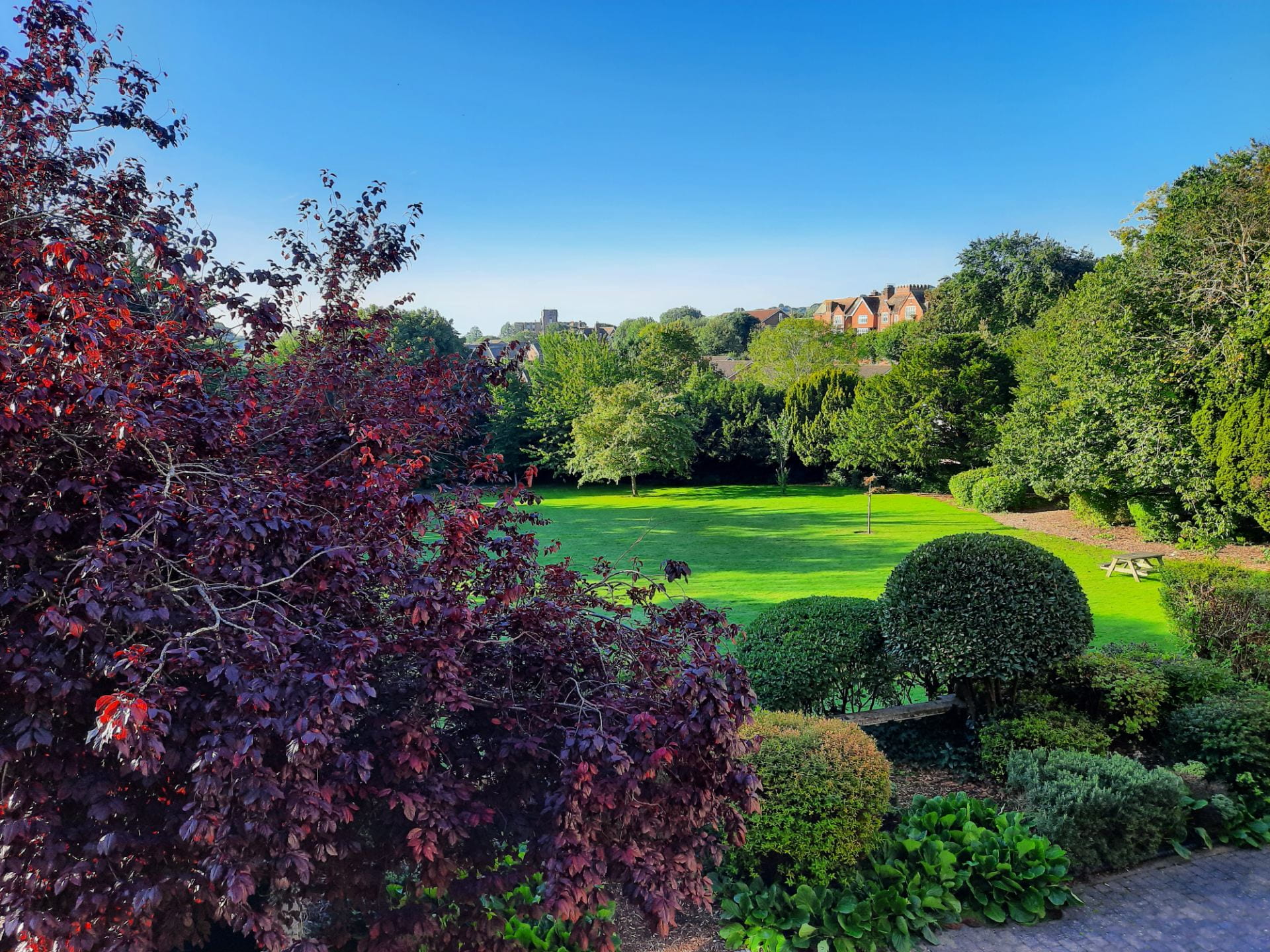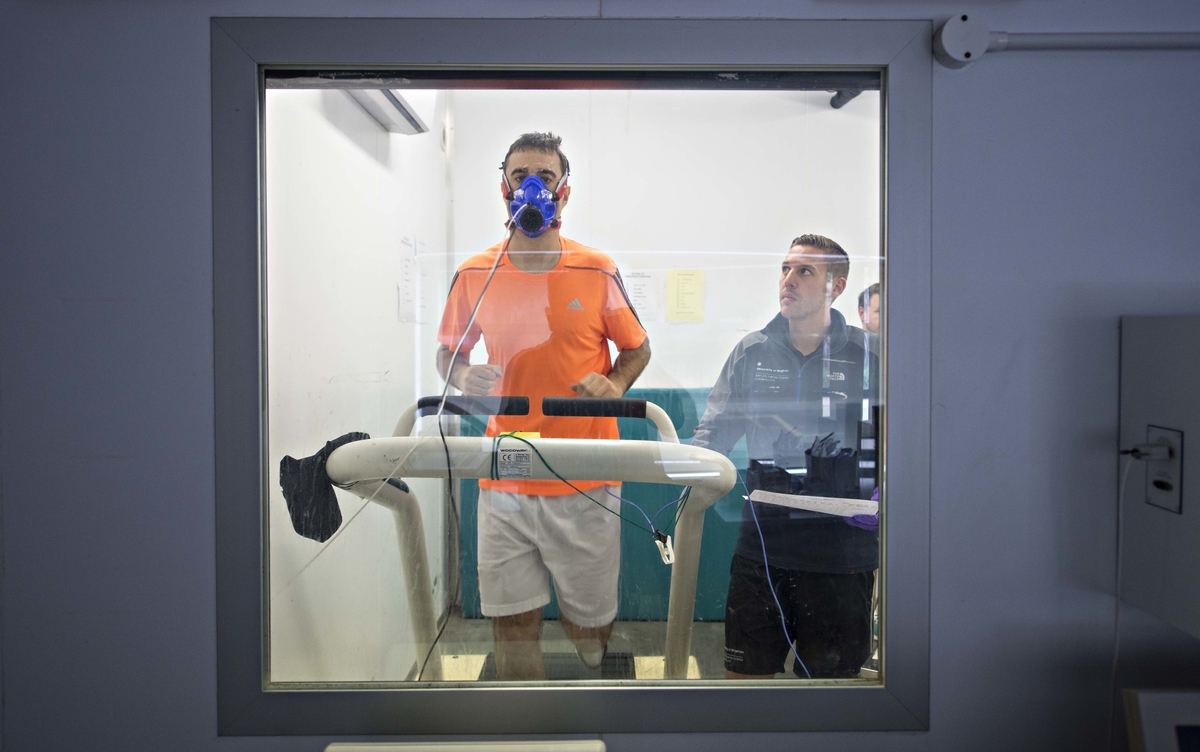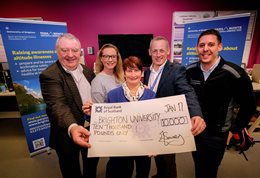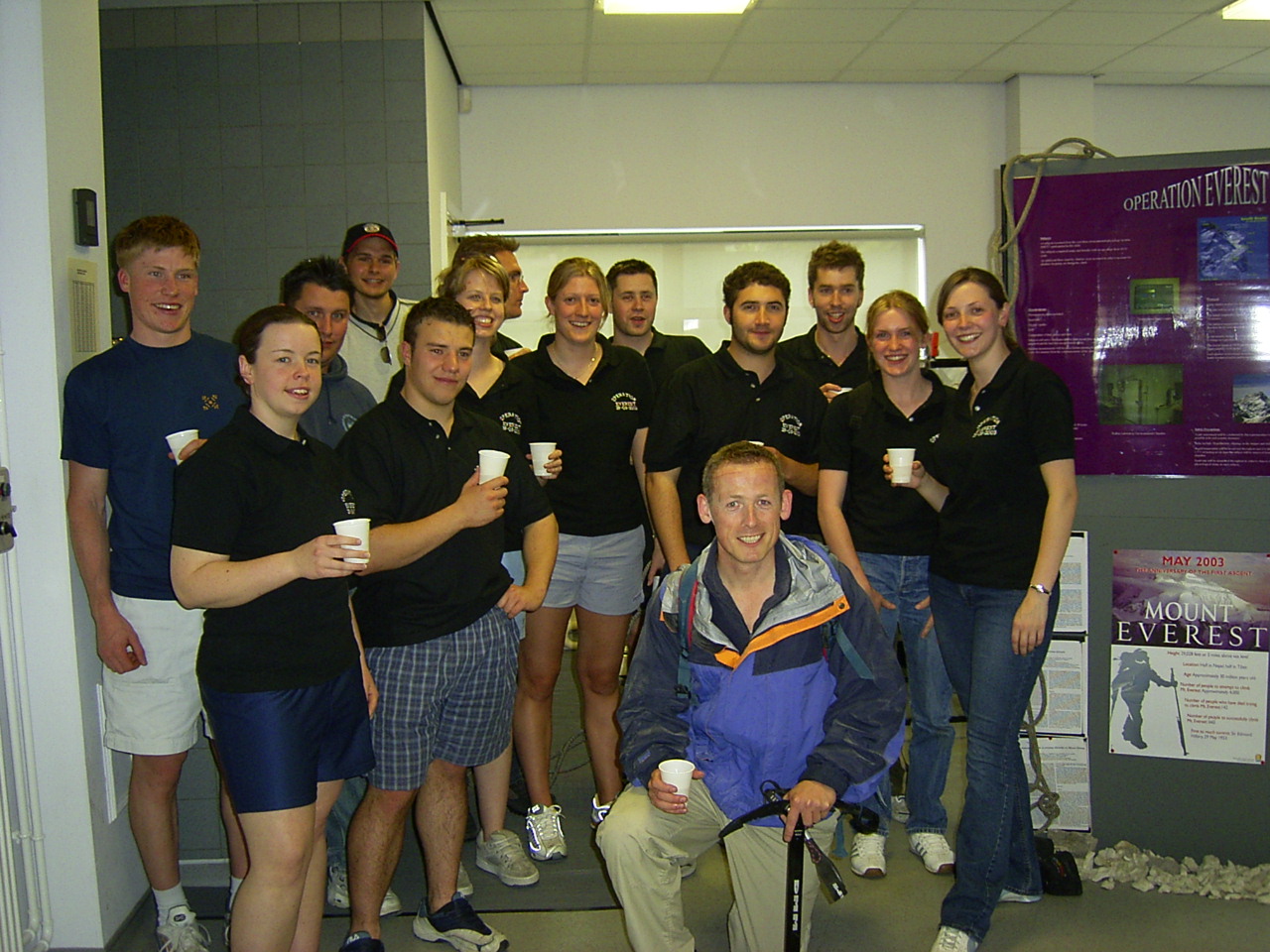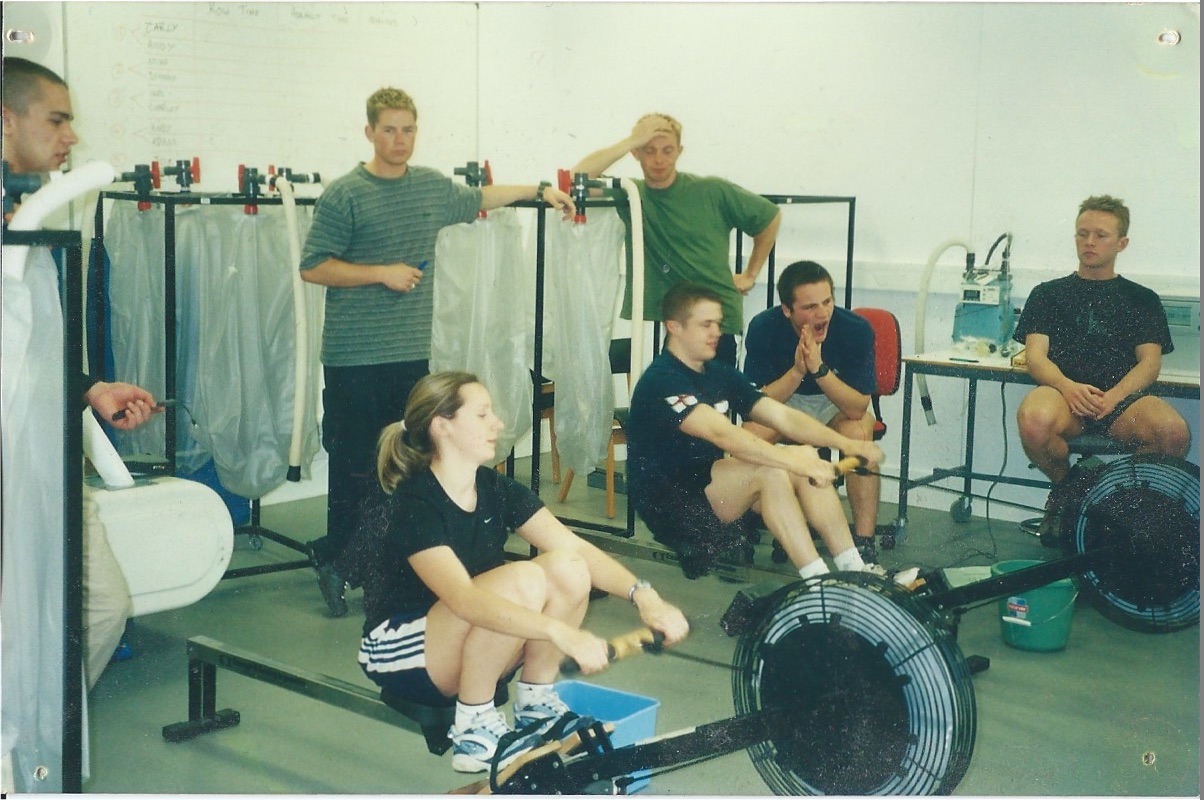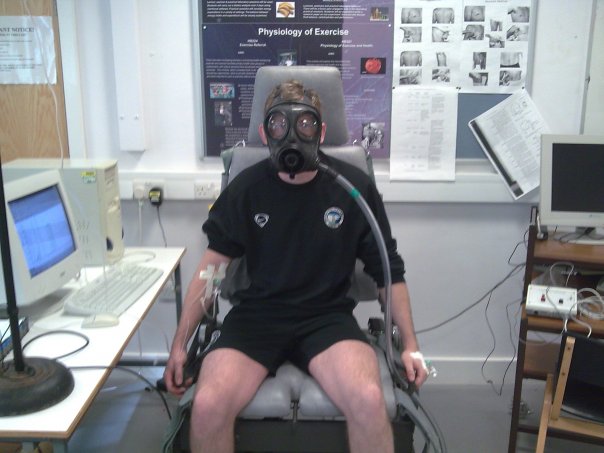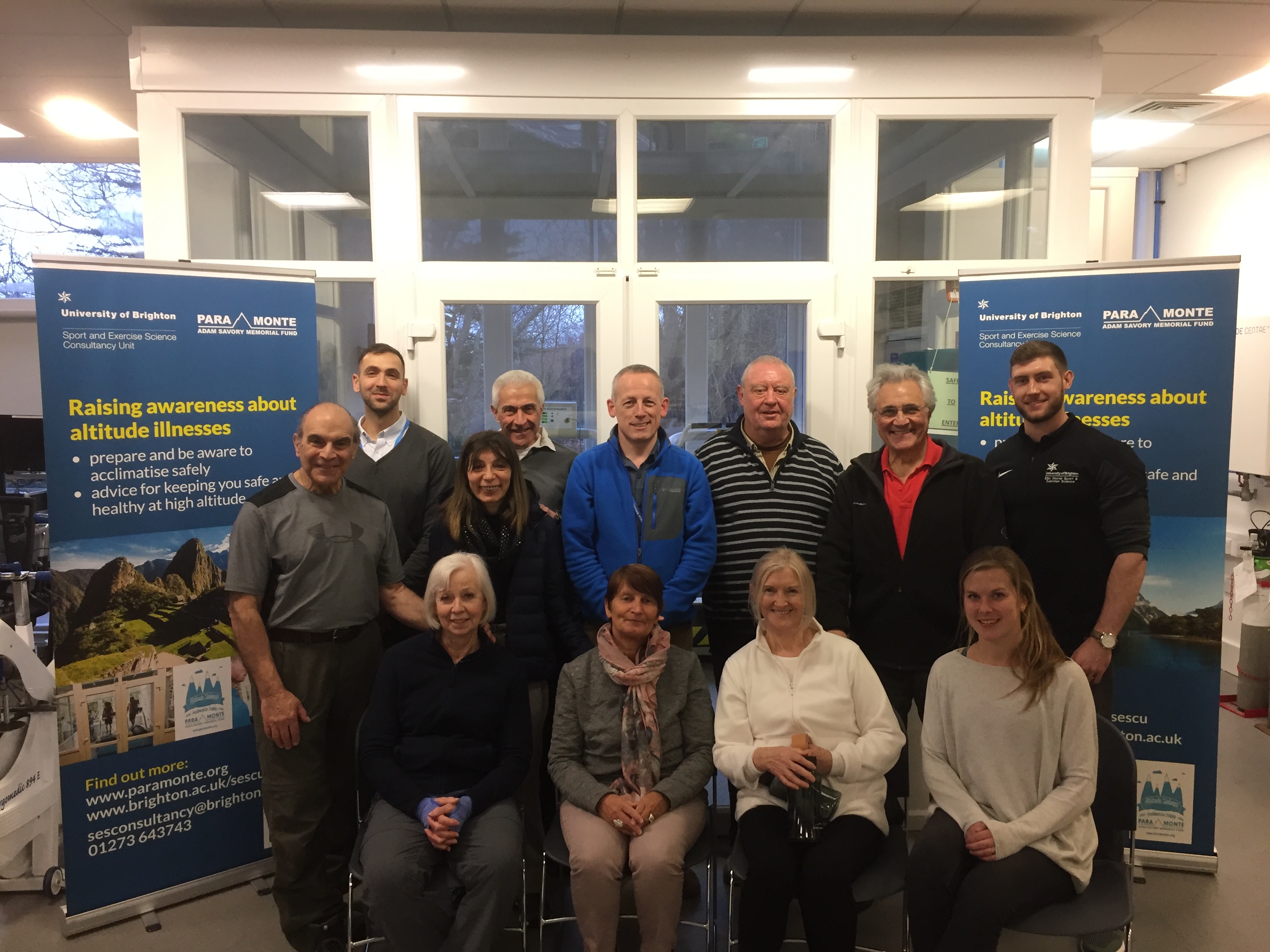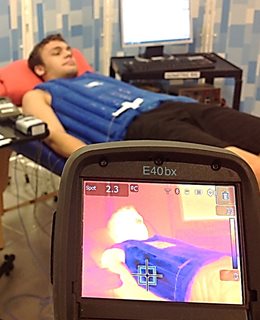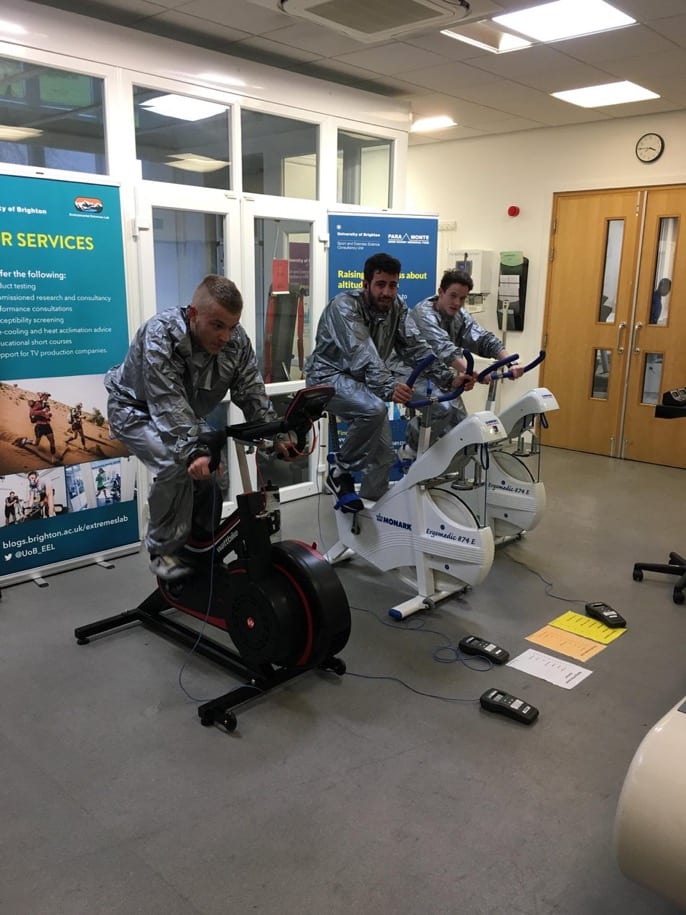
After 26 years and 302 days working at the Eastbourne Campus of the University of Brighton, the day has finally arrived when we officially close the Welkin Sport and Exercise Science Laboratories for good and start their decommission before recommissioning on the Falmer Campus. Considering this significant occasion, I felt a last blog post from Eastbourne that captured some recent activities of the Environmental Extremes Lab and a whistle-stop tour through some highlights and notable statistics from over the years was in order.
SI627 – Expedition Physiology – Expedition
With change in the air, after 20 years heading to the Bannau Brycheiniog (Brecon Beacons), we relocated this year to a more local SI627 Expedition in the Sussex Downs National Park. With the physiology theory safely stored in their back pockets from semester 1’s content, our students embarked upon this year’s expedition armed with a crash course in essential navigation skills…what could possibly go wrong! Four walking groups of students set off, but did not have to put up with the humour (or lack off!) from the staff for hours each day, instead meeting them at checkpoints Duke of Edinburgh style, where they carried out different assessments of basic and advanced navigation skills. On the 2nd day and to add some spice, each group had to carry round an egg and try not to break it before arriving back to basecamp – Alfriston Campsite. All groups did really well as the photos below suggest, in both their group navigation (not getting lost…much!) and in carrying the eggs, even if there were a few breakages and eggy pockets by the end. How is it, we go 20 years to Wales and do not have to visit A&E once, then on our first local expedition, a slip on wet ground and hyper-extended knee resulted in one of our students, Ben Gent, needing to be picked up early and taken down to the Eastbourne DGH…Sod’s law! Fortunately, we had our very own comedian in Bill Norton to keep Ben’s spirits up while waiting to be seen. In spite of the incident, which Ben has recovered from, it was a great expedition for everyone that had everything; drama, thick fog, gale-force winds, glorious sunshine, noisy snorers and very loud animals (we think badgers) fighting in the woods and of course the obligatory campfire regaling past adventures while toasting marshmallows. The students walked nearly 50km over 3 days which was pretty good going with the inclement weather they faced and so they should be very proud. Roll on SI627 Expedition 2025 for another great adventure!
Marathon Des Sables
For another year, we translated our knowledge around chronic heat mitigation strategies to benefit a talented athlete, John Dewey, heading off to complete the 2024 Marathon Des Sables (MDS). This has been an annual occurrence for over 10 years here at the University of Brighton that has been captured across previous blog posts we wrote in 2016, 2017, 2018, 2019 and 2021. Our approach to delivering annual heat acclimation support to MDS athletes is to give the opportunity to our MSc Applied Sport Physiology and MSc Applied Exercise Physiology students so they can develop their hard technical and softer interpersonal skills en route to being an applied physiology practitioner. This year it was MSc Applied Exercise Physiology student, Vicky Breen, who led the MDS Heat Acclimation Programme with support from fellow MSc students Tom Mccreadie, Kevin Gittens and James O’Connell as well as Technical Instructor, Bill Norton. The support was spread over two blocks with a few months in-between to optimise heat adaptation. Coached by double MDS champion, Elisabet Barnes, who we also provided heat acclimation support to in the past, John finished a very impressive 8th overall and the first from the UK, with a time of 24 hours, 21 minutes and 23 seconds out of 781 finishers (587 men). Congratulations obviously goes out to John for a herculean performance and Elisabet for her superb coaching, but also to Vicky and her team. They had to contend with a good number of obstacles along the way, not least a 23 year old environmental chamber that had worked hard for many years but was giving up the ghost!
Hi Vicky, thanks so much! It was an epic adventure as expected!
I was often thinking of all of your advice! Especially on the long day: after 75km I stopped at the final checkpoint in sweltering heat to get my core temp down before finishing the last 11km much more strongly. That decision saved my race.
John

Para-Monte Altitude Awareness Day
We were fortunate to squeeze in a final altitude awareness session on the 19th April as we supported three ladies, all off on different altitude adventures (Annapurna Sanctuary Trek – Nepal, Kilimanjaro, Tanzania and Machu Picchu, Peru). We had great support from BSc (Hons) Sport and Exercise Science students (Gabe Briceno and Matt Riley) and BSc (Hons) Exercise, Health Rehabilitation Science student, Steph Baker, who supported Mr Bill Norton and Dr Neil Maxwell. We were especially pleased that Para-Monte Charity founders Chris and Jeannet Savory were able to join us during our last altitude awareness session in Eastbourne. They supplied Para-Monte beanies to Marie, Jill and Anne to take with them and spread the Para-Monte message – “Be Altitude Aware”. The day comprised of some baseline measures being taken before altitude screening in our hypoxic chamber, comparing physiological responses in hypoxia to sea level. Then Bill delivered the Para-Monte Altitude Talk; his first time and like a pro, giving the clients an opportunity to understand the signs and symptoms of major and minor altitude illnesses, what they can do for themselves and finally, ask any questions. All-in-all, a great day and we wish each of them a safe, successful and enjoyable expedition.
The timing of our altitude awareness session coincided nicely with research we were a part off led by Dr Ash Willmott who will present it at this summer’s European Congress of Sport Sciences (ECSS) in Glasgow. The poster that Ash will present captured the value of educational interventions in raising altitude awareness. Not surprisingly, we found that from a few months away from explicit educational input this resulted in a reduction in altitude awareness, but a “top-up” educational session in the form of our 5-min animated video helped to restore altitude knowledge to a high level. Not to steal Ash’s thunder, the full poster will be made available after the conference!

Heat Impacts on Females and their Health
We were delighted to support Dr Jess Mee in her application for a UKRI Future Leader’s Fellowship where she was awarded £0.9M over 4 years to investigate the impact of heat strain on women’s health and performance. This is a much coveted grant and receiving the award is testament to Jess’ existing research capabilities, empathetic nature and passion to make a difference in this important field. Jess began the project officially in April and has some really exciting plans that were captured when the University of Worcester released the news. We have really enjoyed working with her so far and were delighted that one of own MSc students, Liv Barnes, was recruited to one of the highly competitive research associate positions. Good luck Jess, you will do great and be an outstanding leader in the future.
Wolfson Foundation Funding for New Environmental Chamber
After over 18 months of work, multiple rounds of applications and an interview, we were delighted that The Wolfson Foundation saw the potential in us to invest £325k worth of funding for a new, dual temperature and hypoxic environmental chamber to enable us to continue our work allied to environmental extremes. Importantly, this will allow us expand our research into the health impacts of climate change on vulnerable populations which as we are increasingly realising is a global imperative. The infographic below we created for the application captures key elements of our vision: for high quality research to translate into advocacy globally, on how to live, work and safely engage in physical activity while in extreme environments, prioritising risk stratification and mitigation/ therapeutic strategies to benefit at-risk populations.

House of Lords
Dr Neil Maxwell was invited to attend The Physiological Society’s event – Building a Roadmap to Global Heat Health Resilience – held in the House of Lords on Wednesday 12th June. It was the launch of a consensus statement that calls on government (when we know who the next will be) and agencies to recognise the challenge that rising temperatures are presenting to human health across the world and the impact they have across a range of policy areas. It was a good event to be part of and the priorities detailed in the consensus statement align well with what we submitted in the Wolfson bid and the Environmental Extremes Lab’s vision.
So these are just a handful of special moments the Environmental Extremes Lab and its members have had in this last academic year. Sadly, there is not enough time before this blog post must go out to capture everything in detail, but it would be remiss not to acknowledge the 51 students who have contributed to the taught environmental physiology curricula across level 5 (SI521), 6 (SI627) and 7 (SI710) as well as 15 BSc dissertations students and 4 MSc research project students whose studies were aligned to environmental physiology this academic year. They are at the core of what we do here in the Environmental Extremes Lab and that is educate and translate research, our own and that of others, so our students can be ambassadors of the future and share their knowledge and experience. We also have our four current PhD students (Greg Eichhorn, Julie Gooderick, Chanel Coppard and Anya Gough) who are all working very hard on their respective PhD studies and are excited at what the new labs in Falmer will offer. We also have the excitement of an outstanding soon-to-be graduate of ours wanting to come back and study for a PhD with us. To the environmental physiology teaching team and technical team (Mark Hayes, Bill Norton, Jake Butterworth, Ann Attfield and Philip Murphy) who have worked tirelessly behind the scenes this academic year to make this rich set of learning experiences possible, a huge thank you!
History of the Welkin Sport and Exercise Science Labs and Provision for Environmental Physiology
Before we jump forward to the new Meads Sport and Exercise Science Laboratories on the Falmer Campus, I hope you will indulge me with a quick step back in time which I hope will be interesting and a wee bit nostalgic to many who have studied and worked here in Eastbourne. The location of the sport and exercise science laboratories, and therefore the provision for environmental physiology, has certainly taken a curious route over the years. Originally, the science laboratories were sited in the main Hillbrow building that later became one of our lecture rooms (G14).


Mr Buckley (technician) talking to students (left, 1959) and Miss Cutland (lecturer) teaching students the measurement of blood pressure (right, 1959) in Hillbrow Science Lab
In the early 1960s, the laboratories were moved over to the Welkin building (where they have been since 2001 until today) and were housed on the first floor of the Welkin building alongside a common room (Photo A, lefthand building, where our exercise physiology and general laboratory existed). At this point however, there was still no coherent existence of environmental physiology in the curriculum or in a research capacity. The righthand building of Photo A is Bishopsbourne – which used to be the College library, then the Student Union. On the ground floor of what is now the Welkin Laboratories Building (Photo B, righthand building) was the Welkin Dining Room and kitchen. The Welkin House (Photo C, lefthand building) housed the sick bay, offices and administration with the top floor left for the Principal’s private quarters. Photo D captures the Welkin Labs, flanked by Welkin House (left) and Bishopsbourne (right) with pristine lawns in front. All photos taken in 1962.

In time, the rehousing of the dining room enabled another laboratory and Dr Ray Watson to move into the old kitchen (effectively where Sportswise, has been housed since 2001) where he taught physiology and carried out physiological support of Olympic athlete – Steve Ovett, OBE, supported by Alan Allchorn (then a senior technician).
However, when the Chelsea College of Physical Education merged with Eastbourne College of Education and Seaford College in 1976, becoming the East Sussex College of Higher Education, the library needed to expand to accommodate more students (Queenwood Library served one part of the campus and the Welkin Library the other part). With the need for more space for the campus library, in the early 1980s the sport science laboratories and the academic staff were rehoused to two other university buildings, Bishop Carey (see photo below) and Sunnymead some 400 m away, allowing the library to take over the entire Welkin Laboratory building.

The emergence of environmental physiology into the curriculum came as the result of Mr Paul McNaught-Davis (one of the physiology lecturing staff who went on to become our Head of School years later) joining the Chelsea College of Physical Education in 1976, which soon became the East Sussex College of Higher Education following a merger of the Chelsea College, Eastbourne College of Education and Seaford College in that year. With a physical education background, a subsequent MSc in Human Biology from Loughborough University (taught by Professor Ernest Hamley) and mentoring in areas allied to environmental physiology from Dr Ray Watson, Paul realised the opportunity for developing the study of sport science and environmental physiology from it. In the same year as Paul’s arrival, Liverpool John Moores (LJM) University started the first BSc degree in Sport Science. In 1977, Paul with colleagues Alan Tomlinson (now Emeritus Professor) and the late Professor Graham McFee visited LJM to learn as much as they could about the course with the intention of starting up an equivalent course. In 1980 the Chelsea School of Human Movement and sport science provision moved to be part of Brighton Polytechnic as it was called (which it was until 1992 when it became the University of Brighton). It was in the same year that they took the bold move of starting the second ever BSc (Hons) Sport Science undergraduate degree in the country. The more senior member of the academic staff at the time, Dr Trevor Wood, led the course very successfully, where the principal objective was the development of the scientific study of sport and exercise, realising the value it could offer many students and those who could benefit from the graduates’ knowledge and experience. [NB. From those early days, where 26 students (16 men, 10 women) were recruited onto the BSc (Hons) sport science degree in the first year, to 50 in the second year, it has grown to at its height 140 students entering the programme].
In 1984 while our laboratories were located in the Bishop Carey Building, it was the intervention of Alan Allchorn (still a senior technician, but who went on to become our Principal Technician in Bishop Carey and School Technical Manager in the Welkin Laboratories) alongside Paul McNaught-Davis’ drive to develop environmental physiology into the curriculum, that convinced Dr Ray Watson that instead of another EEG pen recorder, we would benefit from a chamber that controlled the environmental conditions. Without internet in those days, Alan Allchorn searched industrial trade directories, located a company (Ringway) and managed to negotiate the price down for our first (blue) environmental physiology chamber (~ 2.5 m x 2.5 m x 1.5 m) costing £9,950! Alan Allchorn and Dave Thomas (Senior Technician), both with engineering backgrounds, were able to install the chamber that resulted in our first, dedicated environmental physiology laboratory. Although temperature was the focus for the chamber, 500L Douglas bags with nitrogen enriched air were fed through tubes into the chamber to create a hypoxic environment as well. In addition to housing a small, blue environmental chamber, the environmental physiology laboratory also had an underwater water tank that Dr Peter Bale predominantly used for densitometry (underwater weighing to estimate body density and then body fat). The first model was originally designed out of plywood by Alan Allchorn and Dave Thomas (essentially a boat inside-out), but sprung the odd leak meaning students and experimenters used the tank without socks or shoes on! Model 2 of the tank was a polypropylene food storage container that Dave Thomas had come across while working in the food industry. To get the tank in the building, Estates had to take the door off and remove a foot of external brickwork and then rebuild the entire doorway!



Our old (blue) Tardis environmental chamber (left photo) with Professor Jo Doust (who became our Head of School after Paul McNaught-Davis) cycling on the ergometer (centre photo) and our own water tank (right photo).
Fast forward to 2001 when we came the full circle and returned to the entire Welkin Buildings to accommodate most for the human performance sport and exercise science laboratories. This move brought a larger, more sophisticated, purpose-built environmental chamber (costing £54k) that could closely control ambient temperature (-20°C to +50°C) and relative humidity (15% to 95%) alongside a less leaky water tank. This led to further expansion in our capabilities for examining human responses to environmental extremes and was a catalyst for growth in teaching, research and consultancy activity. In 2009, a purpose-built hypoxic chamber costing £85k joined our existing facilities that enabled us to simulate altitudes equivalent to 5000 m and examine susceptibility to injuries, such as acute mountain sickness, provide support to those embarking upon extreme challenges to altitude, as well as explore the interaction between hypoxia and health.



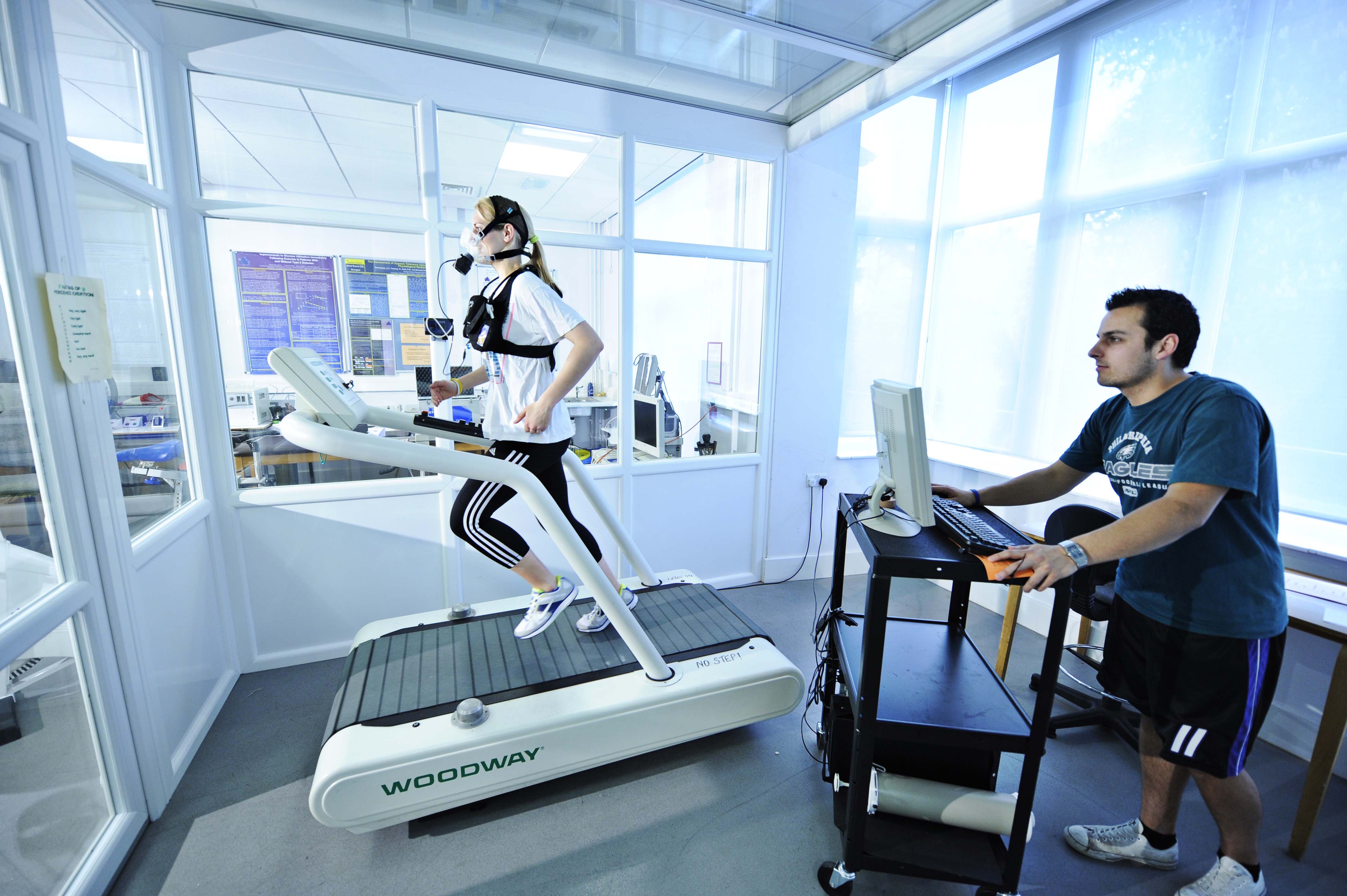
Notable Statistics
The presence of environmental physiology at the University of Brighton dates back over 50 years to when a former lecturer (Dr Ray Watson), provided physiological support to Kip Keino ahead of him winning gold over 1500 m at the 1968 Mexico City Olympics. The success of Kip Keino and other Kenyan runners in the Mexico City Olympic Games was certainly a catalyst for altitude training research and its benefactors thereafter. From these early days to the Chelsea School, then the School of Sport and Health Sciences, there has been a strong commitment to the study of environmental extremes on human function, now reflected through our Environmental Extremes Lab (and the extended team that contribute). This commitment has led to an important body of high-quality research that has contributed to the last three research evaluation exercises (RAE/REF) in terms of highly cited publications, PhD awards, and impact case studies – summary of most recent – Protecting the health of Paralympic, Olympic and World Cup competitors. To-date the Environmental Extremes Lab have published 103 papers in peer-reviewed journals, secured external research and knowledge exchange funding as principal investigators (>£750k) and as co-investigators (>£5.1M) and supported 15 PhD students to completion; all with an environmental physiology focus.
This critical mass of research evidence led to Brazil’s National Olympic Committee endorsing our research ahead of the Rio 2016 Olympics and the then English Institute of Sport (EIS, now UK Sports Institute) to commission us to write an 87-page heat optimisation strategy report in 2018 ahead of Tokyo 2020/1 Olympic and Paralympic Games for Team GB. With a Memorandum of Understanding between the University of Brighton and the EIS, our research informed their policy and practice. We advised England Rugby on their heat acclimatisation strategy ahead of their Tokyo 2019 World Cup. Presentations by our team (2018-2020) to Team GB doctors, coaches and science practitioners, showcasing ours and others’ research reinforced the importance of developing bespoke, sport-specific and medically-based heat strategies for the health of the athletes and support staff. As part of our Tokyo preparations, in 2018/19, nineteen of our BSc students carried out eight research projects identified as a priority to improve chances of GB winning medals at the Games as part of their dissertation projects. The poster below captures this and some more unusual statistics emerging from the research! We were invited by the journal, Temperature, to capture this body of research which was led by Dr Oli Gibson, entitled, ‘Heat alleviation strategies for athletic performance: a review and practitioner guidelines’ and has been one of their most read papers of that journal (>24k views and > 100 citations). In 2020, the international Paralympic Association commissioned us to create a series of athlete/coach-centric policy presentations to advocate hydration, cooling, heat acclimation and heat illness prevention for a global audience. What a whirlwind of a journey the Environmental Extremes Lab went through, catapulting ourselves into the professional and public eye.

Using the principle above and knowing we have had 23 years in the Welkin Labs (2nd time round), if we just use BSc dissertations, MSc research projects and PhD and MPhil research student studies alone (so not counting the hundreds of environmental physiology 1st, 2nd, 3rd year and MSc labs and self-designed studies using our temperature-based environmental chamber), and gu-estimating each year averaged a dozen heat studies [10 participants per study, 3 exercise-heat trials per study of ~ 1.5 h per trial per study, 40 hours per study (which we all know for heat acclimation studies is grossly underrepresenting the true value) and on average 1.5L/hr sweat rate], we could scale this up to some quite eye-watering statistics!
A Nostalgic Walkabout of the Welkin SES Laboratories and its Activities
So, as we come to a close of this rather historical and sentimental trip down memory lane, I hope the following collection of photos allow you to reminisce of the Welkin Laboratories, what they meant for you and gave to you.
The Next Chapter in the Journey of the Environmental Extremes Lab
We must now look to what lies ahead and maybe seek inspiration from a quote by C.S. Lewis. There are enormous opportunities for us in Falmer, both in the new Meads Sport and Exercise Science Laboratories, but in our proximity to new collaborations with the Brighton and Sussex Medical School, the School of Applied Sciences and in the Brighton and Hove area itself. We have made some bold aspirations in our successful bid to the Wolfson Foundation and now it is time realise them.
You can’t go back and change the beginning but you can start where you are and change the ending
C.S. Lewis

But before we head 20 miles west along the coast to the Falmer Campus, let me have one last look out of my office window before we go!
